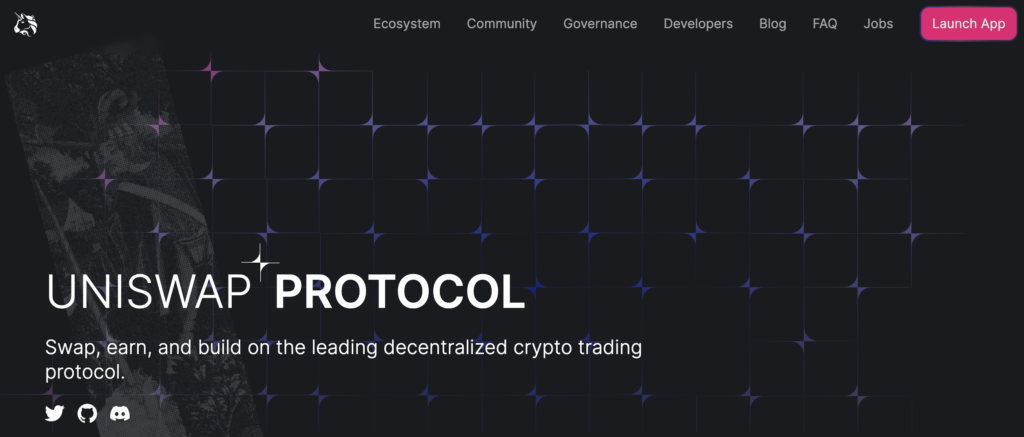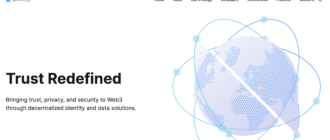Uniswap represents a paradigm shift in decentralized finance (DeFi) by providing an automated liquidity protocol powered by a constant product formula. Unlike traditional exchanges, it operates entirely on-chain and is built on the Ethereum network, allowing users to swap ERC-20 tokens without the need for an order book.

History of the Project
Developed by Hayden Adams, Uniswap launched in November 2018, inspired by a concept proposed by Ethereum creator Vitalik Buterin. It emerged from an Ethereum hackathon, quickly gaining traction and funding from major entities like Ethereum Foundation and Paradigm. Uniswap stands out due to its contribution to the DeFi explosion in 2020, establishing itself as a cornerstone of the Ethereum-based DeFi ecosystem.
What is Uniswap?
Uniswap is a decentralized exchange (DEX) protocol that allows users to swap various cryptocurrencies in an automated setting. Its primary function is to facilitate automated trading of DeFi tokens and improve the efficiency of trading by solving liquidity issues associated with traditional DEXs through an innovative liquidity pool concept.
How Uniswap Works?
Uniswap’s architecture is deeply integrated with the Ethereum blockchain, relying on its robust smart contract capabilities to manage its core operations without centralized control or intermediaries. Here is a detailed exploration of the technology underpinning Uniswap and its distinctive features compared to other projects:
Ethereum Blockchain
Uniswap is built on the Ethereum blockchain, utilizing its infrastructure to execute complex decentralized finance (DeFi) transactions. Ethereum’s role as a host for Uniswap is critical due to its widespread support for ERC-20 tokens and its ability to execute Turing-complete smart contracts, which are essential for the autonomous and programmable features of Uniswap.
Consensus Mechanism
As a protocol on Ethereum, Uniswap indirectly relies on Ethereum’s consensus mechanism. Initially, this was Proof of Work (PoW), but after Ethereum’s upgrade to Ethereum 2.0, it has transitioned to Proof of Stake (PoS). This shift significantly impacts Uniswap by potentially reducing transaction fees and improving transaction throughput due to the increased efficiency of PoS over PoW.
Automated Market Maker (AMM)
At the heart of Uniswap’s technology is its use of an automated market maker (AMM) model. Unlike traditional exchanges that use order books to match buyers and sellers, Uniswap uses a constant product formula (x * y = k) to automatically determine prices based on the relative supply of the two involved tokens in a liquidity pool. This model allows Uniswap to provide continuous liquidity, irrespective of the order size.
Smart Contracts
Uniswap’s functionality is driven by a series of smart contracts that manage liquidity pools, govern interactions and transactions, and enforce the AMM rules. These contracts are open-source and are deployed on the Ethereum blockchain, providing transparency and security. Each pool’s smart contract holds reserves of two tokens and ensures that the product of their amounts remains constant, thereby enabling trading at calculated prices based on current reserve ratios.
Liquidity Pools and Tokens
Liquidity providers fund the liquidity pools by depositing an equivalent value of two ERC-20 tokens, which then facilitates trade between those tokens on the platform. In return, providers receive liquidity tokens, representing their share of the total pool. These tokens can be redeemed for the underlying capital, along with a portion of the trading fees, at any time.
Flash Swaps
Uniswap’s flash swaps feature allows users to withdraw an unlimited amount of ERC-20 tokens without an initial cash outlay, with the stipulation that they either pay for or return these tokens within one transaction block. This feature is significant for arbitrageurs and developers who need to optimize their strategies across different platforms without committing large amounts of capital upfront.
Unique Selling Points
Uniswap differs from other decentralized exchanges in its minimalistic functional approach, eliminating the need for order books and complex user interfaces. Its reliance on the AMM model and the liquidity pool concept democratizes trading and liquidity provision, making it accessible to a broader audience without requiring significant capital. Furthermore, its integration into the Ethereum ecosystem allows it to benefit directly from Ethereum’s security and network effects.
In conclusion, Uniswap leverages a combination of Ethereum’s smart contract functionality, an innovative AMM mechanism, and unique features like liquidity pools and flash swaps to offer a decentralized and self-regulating trading platform. This technological blend not only supports Uniswap’s operational efficacy but also enhances its scalability and security, setting it apart from other players in the DeFi space.
Tokenomics of Uniswap
Token Classification
The UNI token is a governance token, functioning within the Uniswap protocol on the Ethereum blockchain. It is an ERC-20 token, which makes it not a native blockchain coin but rather a token built on the existing Ethereum infrastructure. This classification affects its usage and governance roles within the Uniswap ecosystem.
Emission Model and Distribution
UNI was introduced to the market through a distinctive distribution mechanism in September 2020. Initially, 1 billion UNI tokens were minted at genesis, with a planned distribution over four years following a set release schedule:
- 60% to Uniswap community members
- 21.51% to team members and future employees with four-year vesting
- 17.80% to investors with four-year vesting
- 0.069% to advisors with four-year vesting
This structured emission is designed to promote long-term participation and governance involvement from the Uniswap community. After the end of the four-year period, a perpetual inflation rate of 2% per year will take effect, intended to continue incentivizing participation in the ecosystem.
Governance and Utility
UNI token holders have the right to participate in the governance of the protocol. This includes proposing changes to the protocol, voting on proposed changes, and managing community treasury funds. The governance system is structured to be completely decentralized, enhancing community-led development and self-sustainability of the protocol.
Economic Incentives
UNI holders are incentivized through several mechanisms:
- Liquidity Mining: Users can earn UNI by providing liquidity to selected pools, which is a critical component of maintaining healthy liquidity levels on the platform.
- Transaction Fees: Although UNI holders do not directly earn a portion of the transaction fees, governance can decide to divert a percentage of fees to UNI holders as a reward in the future.
Market Performance
The market value of UNI tokens is subject to fluctuations based on market dynamics, including demand for decentralized finance (DeFi) services, changes in Ethereum’s price, and overall crypto market conditions. Since its launch, UNI has seen significant volatility but remains a top token in the DeFi space due to its foundational role in Uniswap.
In conclusion, UNI’s role as a governance token with a clear emission schedule and potential for perpetual inflation post-initial distribution phase supports its long-term viability and utility in the Uniswap ecosystem. Its integration into governance and liquidity mining initiatives ensures that it plays a central role in both the operational and strategic facets of the protocol.
Where to Buy UNI Token?
UNI tokens can be purchased on several leading cryptocurrency exchanges that support a wide range of crypto assets and offer robust trading features. Here’s where you can buy UNI:
- Binance: As one of the largest and most popular cryptocurrency exchanges globally, Binance offers extensive trading pairs for UNI, including against major cryptocurrencies like Bitcoin (BTC) and Ethereum (ETH), as well as fiat currencies.
- HTX (formerly Huobi): Known for its liquidity and security, HTX provides various trading pairs for UNI, facilitating both spot and margin trading.
- MEXC: Offers competitive trading fees and a user-friendly interface for buying and selling UNI, with options for futures trading as well.
- Bybit: While primarily known for derivatives, Bybit also offers spot trading for UNI, providing traders with options for leveraged trading.
- KuCoin: This exchange is favored for its wide range of cryptocurrencies, including UNI, and is known for being friendly to traders from a diverse range of geographical locations.
- Bitfinex: Offers advanced trading features and high liquidity for UNI, catering to both novice and experienced traders.
Where to Store UNI Token?
Storing UNI tokens safely is crucial for security and effective participation in Uniswap’s governance. Here are recommended wallets for storing UNI:
- MetaMask: This Ethereum-based wallet is widely used for interacting with DeFi applications directly from the browser. It allows users to store UNI and also participate directly in Uniswap’s governance voting.
- Ledger Nano X/S: For those seeking hardware wallet solutions, Ledger Nano provides a secure option with offline storage, protecting your UNI tokens from online threats. It supports Ethereum and ERC-20 tokens such as UNI.
- Trezor: Another secure hardware wallet option, Trezor, allows users to manage UNI tokens while ensuring that the private keys never leave the device.
- Trust Wallet: A mobile wallet that supports a multitude of cryptocurrencies including UNI. It offers an easy-to-use interface for managing and swapping cryptocurrencies.
Each of these wallets provides unique features, such as direct integration with DeFi platforms, robust security measures, and user-friendly interfaces, catering to diverse needs and preferences of cryptocurrency users.
Growth Prospects and Development Forecast of Uniswap
Foundations of Growth
Uniswap’s growth is primarily driven by its pivotal role in the decentralized finance (DeFi) sector, serving as a primary exchange mechanism for ERC-20 tokens on Ethereum. Its innovative automated market maker (AMM) system and decentralized governance structure attract both retail and institutional participants, ensuring a broad and diversified user base. The protocol benefits from the overall growth in DeFi, increased adoption of blockchain technology, and the continuous development of Ethereum, particularly advancements in scalability and transaction efficiency.
Clients and Partners
Uniswap serves a wide range of users, from individual traders and crypto enthusiasts to DeFi aggregators and institutional investors looking for decentralized trading solutions. Its clients include:
- DeFi Platforms: Other DeFi protocols often integrate Uniswap for liquidity and exchange services, such as Compound, Aave, and MakerDAO.
- Wallets and Interfaces: Wallet providers like MetaMask and MyEtherWallet incorporate Uniswap functionalities, allowing their users to directly interact with Uniswap’s liquidity pools.
- Blockchain Analytics Tools: Services like CoinGecko and CoinMarketCap utilize Uniswap’s data for real-time market analysis and price tracking.
Partnerships with Ethereum scaling solutions like Optimism and Arbitrum also enhance Uniswap’s transaction speeds and reduce costs, which are pivotal for maintaining its competitive edge.
Development Forecast
The future development of Uniswap is expected to focus on enhancing its scalability through Layer 2 solutions, which will help manage higher throughput and lower transaction costs, making it more accessible. Further innovations in AMM algorithms and liquidity pool management are likely to attract additional liquidity providers. As blockchain adoption continues to grow globally, Uniswap is poised to maintain or even expand its market share in the decentralized exchange space.
The Uniswap Ecosystem
The Uniswap ecosystem encompasses a variety of projects and services that integrate or build upon its protocol, including:
- Layer 2 Scalability Projects: Projects like Optimism and Arbitrum that work with Uniswap to offer faster and cheaper transactions.
- Governance Platforms: Snapshot and Tally, which facilitate UNI token holders in participating in governance decisions.
- Liquidity Management Tools: Services such as Pools.fyi and UniswapROI, which help liquidity providers monitor pool performance and potential returns.
- Educational and Community Initiatives: Uniswap frequently engages with its community through educational programs, grants, and development initiatives that support the broader ecosystem.
In conclusion, Uniswap’s growth prospects are solid, backed by its innovative technology, strategic partnerships, and a robust user base. Its adaptability and commitment to community-driven governance further enhance its position within the DeFi landscape, promising a sustainable and progressive development trajectory.
Conclusion
Uniswap’s unique approach to decentralized finance via its AMM protocol and constant product formula has positioned it as a leader in the DEX category. With continuous upgrades and a robust governance model through the UNI token, Uniswap is poised for further growth and possibly deeper integration into the broader blockchain ecosystem, continuing to influence the DeFi landscape significantly. As the project evolves, it offers compelling opportunities for advanced users and investors looking to leverage cutting-edge financial technologies in the cryptocurrency space.






